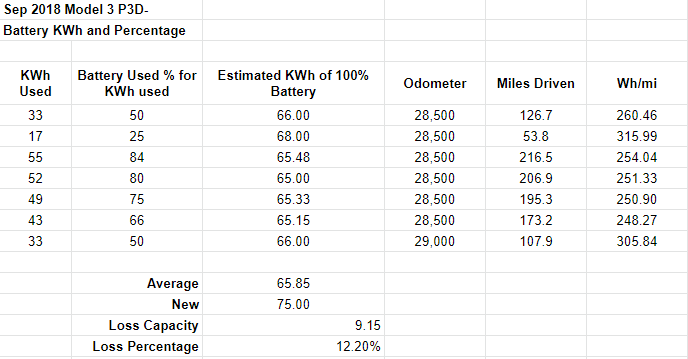Candleflame
Active Member
I assume this was an extrapolated number and not shown on the display (I've never seen a picture of an LR AWD 2018/2019 showing more than 310 rated miles).
Oh, I know. But remember that 310 rated miles is likely "capped" cleverly. 2018 cars started at at least 77.5-78kWh based on known SMT data. If you use the simple constant, that equates to 318 rated miles (78kWh/245Wh/rmi = 318rmi). Tesla likely "cleverly" conceals this by inflating the rated miles energy content (so it is higher than 245Wh/rmi) until you hit the degradation threshold of 76kWh (310rmi*245Wh/rmi = 76kWh) (that's why 2018/2019 cars didn't show degradation for a few months, typically). This way, you'll see rated miles immediately start to click off when the car is new, but they click off slightly more slowly when the car is new (about 2.5% more slowly). Tesla benefits from this because no one freaks out that their car shows fewer rated miles than another owner, and they can ship batteries that have a small variability (probably 2-3%) in initial capacity - and they all display as having the same initial 310 rated mile range, as long as they start over 76kWh. (For 2020 AWD, this threshold has changed to 77.6kWh, BTW, so they'll need tighter tolerance on that initial capacity to achieve the same result - closer to 1-1.5%.)
You're below the threshold, so we can definitively say you have about 306rmi*245Wh/rmi = 75kWh of energy remaining when your battery is fully charged.
It's very likely given your capacity loss performance and the age of the car that you started with over 78kWh (if you had had SMT from the beginning you would know this for sure, but you'll have to trust me). Looks like you started with a great battery, likely with 1-2kWh more capacity than some other owners.
So that would be 75kWh/78kWh = 96%, so 4% capacity loss.
There's not really any doubt here - keep in mind that Tesla published the capacity of the battery in their EPA-submitted documents to be in excess of 79kWh, for 2018, 2019 and 2020. (For whatever reason this appears to translate to closer to 78kWh in SMT, but this is kind of a side issue. The exact discrepancy is unknown since I've never seen an SMT readout on a brand new vehicle, or even one that is just a week or two old with a few thousand miles on it (more representative of the EPA test article).)
I think thats because there is currently no standard to measure battery capacity for cars. Maybe Tesla gave them a 0.1c discharge rate where the batteries probably produce a lot more than 78kwh.
Yes it's down to how you drive the car, but like I'm saying they're overpromising in the sense that the EPA testing is flawed, yet they still went by it's #s. I have to actually drive my LR AWD efficiently if I want the rated mileage (which is really really really hard, seeing how much power/fun it is), while in my previous car (prius), it is much much easier to hit the EPA rated mileage without even trying to drive it efficiently at all and if I tried (hypermiling) then I can really really beat the EPA mileage rating by a long shot.
The funny thing is that I'm watching Bjorn do a range test on a model 3 in California highway traffic going 90km/h (55mph equivalent, funny how he doesn't switch it to mph even when he's in the states), and yes he blows the mileage range out of the water, but he's pretty much going way under the speed limit (and everyone around him) AND he's limiting his AC use.
So it goes back to the OP that they feel they have battery degradation because they look at the (ever changing) mileage calculation of their 3 and compare that to what the stated range should be (on paper), and it'll never be what it's stated because they don't drive their 3 like they want to save every last drop of energy.
thats normal. its easier if you dont switch. I.e. I drove in the UK for many years with km/h even though I learned driving there. After a while when you look at a speed sign 20 -> 30 30 -> 50 40 -> 65 50 -> 80 60 -> 100 70 -> 110 just happens automatically in your mind.
km/h is also a bit easier to use imho due to smaller increments. mph everything is so close together...




